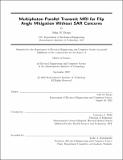| dc.contributor.advisor | Wald, Lawrence L. | |
| dc.contributor.author | Drago, John M. | |
| dc.date.accessioned | 2023-01-19T18:44:20Z | |
| dc.date.available | 2023-01-19T18:44:20Z | |
| dc.date.issued | 2022-09 | |
| dc.date.submitted | 2022-10-19T18:57:03.787Z | |
| dc.identifier.uri | https://hdl.handle.net/1721.1/147305 | |
| dc.description.abstract | High-field magnetic resonance imaging (MRI) excitation performed using a standard birdcage volume coil suffers from a flip angle inhomogeneity problem. For example, in 7 T brain MRI, such an excitation has a flip angle as much as three-fold higher in the center of the head than near the periphery. This is due to a wave interference effect, whereby the wavelength of the applied excitation field (B1) becomes comparable to the dimensions of the human body creating a pattern of constructive and destructive interference from current elements around the head. This interference can be partially mitigated by separating the sources into multiple, individually-controllable elements in a process known as parallel transmit (pTx). While these multiple high-power, high-frequency transmit channels can solve the flip angle inhomogeneity problem, they are expensive and complicate the management of electromagnetic power dissipation in the body, known as the specific absorption rate (SAR). In pTx, SAR strongly depends on how the array elements are energized and must be modeled for each excitation pulse using a body model that accurately approximates the subject.
This thesis presents a novel use of the seldom-considered multiphoton excitation phenomenon. Our multiphoton pTx (MP-pTx) method uses a conventional birdcage transmit coil (a single high-frequency channel) to apply an on-resonant B1 field that is supplemented with an array of low-frequency z-directed coils, in order to address the spatial flip-angle homogeneity problem. Using only low-frequency coils in the array helps lower cost and significantly simplifies SAR management, since SAR is negligible at low-frequencies – independent of how the array is energized. This thesis presents the characterization of the multiphoton method in experiments and simulations and develops an optimization framework for MP-pTx pulses. A proof-of-concept simulation of the resulting excitation shows that MP-pTx can create a more homogeneous excitation at high field strengths. | |
| dc.publisher | Massachusetts Institute of Technology | |
| dc.rights | In Copyright - Educational Use Permitted | |
| dc.rights | Copyright MIT | |
| dc.rights.uri | http://rightsstatements.org/page/InC-EDU/1.0/ | |
| dc.title | Multiphoton Parallel Transmit MRI for Flip Angle Mitigation Without SAR Concerns | |
| dc.type | Thesis | |
| dc.description.degree | S.M. | |
| dc.contributor.department | Massachusetts Institute of Technology. Department of Electrical Engineering and Computer Science | |
| dc.identifier.orcid | 0000-0003-0335-1562 | |
| mit.thesis.degree | Master | |
| thesis.degree.name | Master of Science in Electrical Engineering and Computer Science | |
